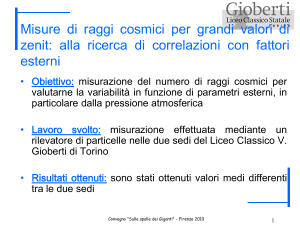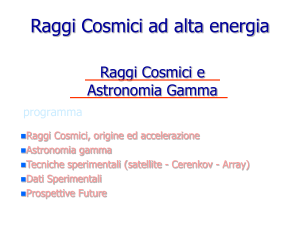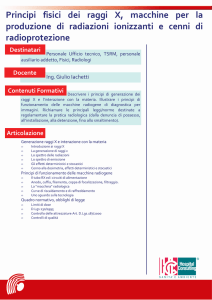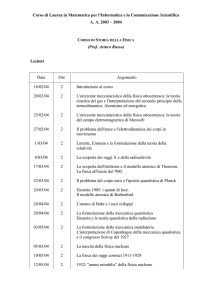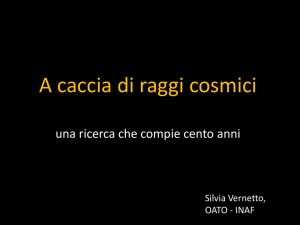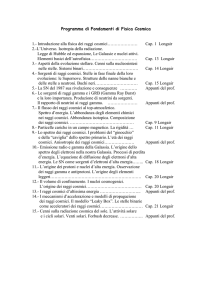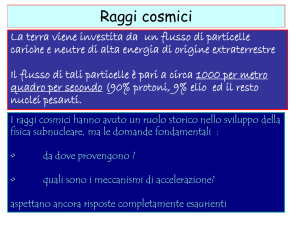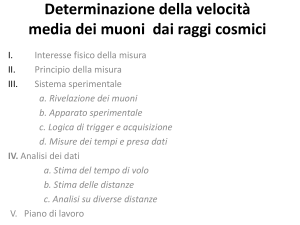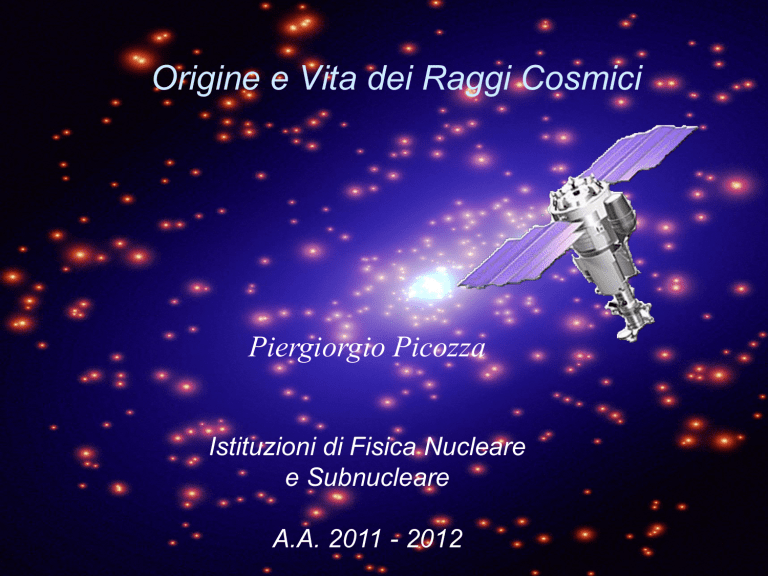
Origine e Vita dei Raggi Cosmici
Piergiorgio Picozza
Istituzioni di Fisica Nucleare
e Subnucleare
A.A. 2011 - 2012
Dal Cielo arrivano
Electromagnetic radiation
radio
IR
Visible
X
g
Particles - charged
- neutral
Gravitational waves ??
p
stable
eelementary
e+
particles
antip
Nuclei
antiN?
other?
n
other?
cosmic
rays
Radiazione Elettromagnetica
Gamma, X, UV, Light, IR, Radio
Non viene influenzata dai Campi Elettrici e
Magnetici
Dà informazioni sulla localizzazione delle sorgenti
emittenti
Non dà informazioni su una eventuale esistenza di
antimateria nel Cosmo
Il Cielo degli occhi
Ammassi di Galassie
Il Cielo dei Gamma
Raggi Cosmici
• Particelle cariche : protoni, antiprotoni, elettroni,
positroni, nuclei , antinuclei (?), Altro (?)
• Risentono dei campi elettrici e magnetici
• Portano da distanze differenti un campione di
materiale galattico ed extragalattico ed accelerato
ad energie molto elevate.
I raggi cosmici
.
• I raggi cosmici sono una delle componenti principali della
galassia. Infatti, la densità di energia dei raggi cosmici nella
nostra galassia è di circa 1 eV/cm3, dello stesso ordine di
grandezza della densità di energia del campo magnetico della
galassia e dell’agitazione termica del gas interstellare.
• Come sono stati scoperti?
Tour Eiffel (Wulf, 1910) :
6 x 106 ions/m3 measured at ground
3 x 106 ions/m3 expected at 80 m
~ zero
expected at 330 m
3,5 x 106 ions/m3 measured at 330 m
Variation of the ionizzation with the altitude (Kolhörster, 1914):
ionization difference in comparison to the ground (x 106 ions/m3 )
0
-1,5
+1,2
+4,2
+8,8
+16,9
+28,7
+44,2
+61,3
+80,4
altitude (km)
0
1
2
3
4
5
6
7
8
9
N(h)=N0 e-h, ~10-3m-1 (for g from radioC: ,~4,5x10-3m-1)
I Raggi cosmici
Il top dell’atmosfera terrestre viene investito da un
flusso di particelle cariche e neutre di alta energia di
origine extraterrestre
Circa due particelle cariche per secondo (essenzialmente
muoni) passano attraverso ogni centimetro della superficie
terrestre.
Primary cosmic ray
~500 km
Smaller detectors
but long duration.
PAMELA!
Top of atmosphere
~40 km
Large detectors but
short duration.
Atmospheric
overburden ~5 g/cm2.
Almost all data on
cosmic antiparticles
from here.
~5 km
Ground
0m
PARTICLE PHYSICS BIRTH WAS DUE TO COSMIC RAYS
Hesse, Wulf, Wilson, Anderson,
Bothe, Kohlorster, Millikan,
Blackett, Skobeltsyn, Rochester,
Butler, Rossi, Pancini ,
Conversi, Powell, Occhialini
……
Advent of accelerators
Abbondanze nei raggi cosmici
• Gli elementi Li, Be, B sono circa 105 volte più abbondanti
nei raggi cosmici che nel sistema solare.
• Il rapporto 3He/4He è circa 300 volte più grande nei raggi
cosmici.
• I nuclei molto pesanti sono più prevalenti nei raggi
cosmici.
• I raggi cosmici attraversano alcuni (4-7) g/cm2 di materiale
interstellare tra la sorgente ed il top dell’atmosfera terrestre
subendo reazioni nucleari che rompono i nuclei più
pesanti.
Ciclo di Vita dei Raggi Cosmici Galattici
Produzione
Accelerazione
Propagazione nel Mezzo Interstellare
Interazione nel Mezzo Interstellare
Fuga dalla Galassia
Confinamento dei raggi cosmici
nelle galassie
Galassia
1 parsec : 3.085 1016 m
1 anno luce: 0.3 parsec
Disco Galattico
Intensità media del campo magnetico galattico: 3G
Tempo di confinamento: ~ 10 milioni di anni
Il campo magnetico
galattico è circa 3mG ed
mediamente parallelo
parallelo al braccio della
spirale della galassia, con
grandi fluttuazioni
Knee region 1015 10 16 eV
1pc=3.1 x 1013 km
1anno-luce=9.5 1012 km
Protone da 5.1019 eV in un campo di 3G
300 pc
30 kpc
Accelerazione dei Raggi
Cosmici
Le esplosioni delle Supernove sono la sorgente
dell’energia responsabile dell’accelerazione dei raggi
cosmici di alta energia
Accelerazione alla nascita mediante lo shock iniziale
Accelerazione quando le onde di shock da supernovae
incontrano il materiale interstellare
Red Giant
Esplosione di supernova
Supernovae Remnants
• When a high mass star (final mass greater than 1.4 solar masses)
collapses at the end of its life a supernova occurs. An enormous shock
wave sweeps through the star at high speed, blasting away the various
layers into space, leaving a neutron core and an expanding shell of
matter known as a supernova remnant. This ejection of matter is much
more violent than occurs in the planetary nebulae that mark the end of
a low mass star, giving expansion speeds of 1.0E3 -1.0E4 km/s. Near
the core of the remnant, electrons emit radiation (synchrotron
radiation) as they spiral at relativistic speeds in the magnetic field from
the neutron star. The ultraviolet portion of this radiation can ionize the
outer filaments of the nebula. In addition the ejected matter sweeps up
surrounding gas and dust as it expands producing a shock wave that
excites and ionizes the gas. This plasma may reach temperatures of
1.0E4 to 1.0E6 K, but with densities of only about 1.0E7 particles per
meter^3.
The big question:
Do SNe produce cosmic-rays ???
V. Ginzburg, Syrovatskii, late 50’s, 1964
F. Hoyle (1960)
….
The SNR hypothesis
• wCR ~ 1 eV cm-3
• dECR/dt ~ V wCR / tesc ~ 3 x 1040 erg s-1
• PSNR,kinetic = 1051 erg / 30 years= 1042 erg s-1
•
dECR/dt ~ 0.03 PSNR,kinetic
Accelerazione
Teoria di Fermi al primo ordine
A NEUTRON STAR WITH A
STRONG MAGNETIC FIELD:
FAST ROTATING PULSAR
(P = 33 msec)
L(spindown) = 5 1038 erg/s
42
Accelerazione dei raggi cosmici
• Pulsars and pulsar nebulae. Pulsars - rapidly rotating
neutron stars left over, e.g., after a supernova explosion exhibit large electric and magnetic fields and act like
dynamos accelerating particles. The pulsar-generated
outflow - the pulsar wind - interacts with the ambient
medium, generating a shock region where particles are
accelerated. Such objects will therefore exhibit a pulsed
component of radiation - from the immediate vicinity of
the pulsar - and an unpulsed component from the shock
region and beyond. The Crab Nebula is one of the few
known TeV emitters of this type, and the best-studied
object.
e-
High Z
[ENTICE, ECCO]
Isotopic
composition
[ACE]
Solar Modulation
Antimatter
Dark Matter
[BESS, PAMELA, AMS]
Elemental
Composition
[CREAM, ATIC, TRACER, NUCLEON,
CALET, ACCESS?, INCA?,
Extreme Energy CR
[AUGER, EUSO, TUS/KLYPVE, OWL??]
Alcune distanze fondamentali
Raggio solare: 696.000 km
Distanza Sole-Terra:
150.000.000 km
•
(215 Raggi Solari) = 1 UA
Grandezza del sistema
solare:150-200 UA
Raggio terrestre: 6380 km


